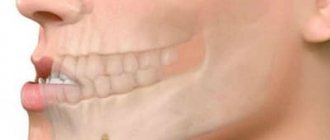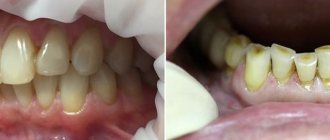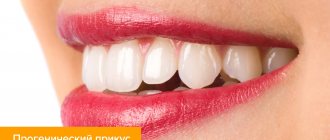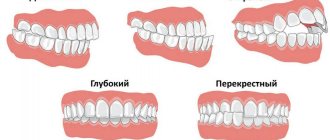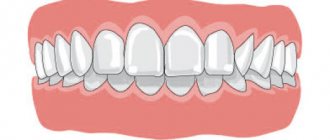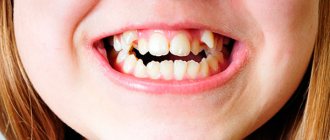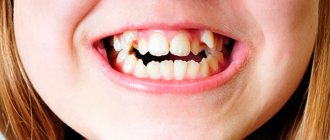Let us pay attention to a problem that is relevant for almost 80% of Russians. Let's figure out how to correct a malocclusion in an adult, because straightening teeth is quite possible not only in childhood. We need to look at the effective ways in which orthodontists make their patients' smiles beautiful and healthy.
We will try to pay maximum attention to the features and differences of the methods so that, if necessary, you can choose the most suitable one for yourself. And be prepared for the fact that the final decision will still have to be made together with the doctor. Because the type of intervention and program of procedures depend on the nature of the pathology, and only a specialist can accurately diagnose its degree and adequately assess the chances of success.
Types of malocclusion
- open - the teeth either do not close at all, or a significant gap is visible between many of them;
- deep – the exact opposite situation, that is, there is an overlap of approximately half the length;
- mesial – the lower jaw, compared to the upper, is moved forward;
- distal – the problem is the opposite of the previous one;
- cross - the right and left sides protrude unevenly, the cutting edges close together.
Other anomalies include:
- diastema - a gap between the front pair of incisors;
- three - noticeable gaps between “neighbors” along the gum;
- twisting - creeping of sixes, fours, fives onto each other;
- transposition - eruption in the wrong places, right up to the palate.
Any of them is not just inconvenient or bad from an aesthetic point of view, but can also provoke the emergence and development of a number of diseases. It develops against the background of genetic abnormalities and heredity, appears due to injuries and loss of bone tissue.
Surgical teeth straightening
Surgery can only correct an abnormal bite, but not straighten the teeth. Surgical intervention is used only in cases where orthodontic treatment is ineffective.
Indications for surgical correction of malocclusion include noticeable skeletal deformities, such as abnormal jaw or chin size.
The operation is performed in a hospital under general anesthesia. Its duration depends on the complexity of the clinical case. After surgery, the patient undergoes a rehabilitation period. He will be able to return to a full life in 3-4 weeks.
Signs of correct bite
Normally, the jaws make close contact when closing. In this case, the upper teeth cover the lower ones by about a third, so that the palatal tubercles of the former touch the incisors of the latter. There are no gaps between them both when the mouth is closed and during chewing. The facial proportions are symmetrical.
Also among the characteristic features:
- absence of speech defects;
- no clicking or other similar discomfort in the joint;
- ease of biting food.
And vice versa, if problems are observed in any of the points just listed, this is an alarm bell and a reason to consult an orthodontist, and immediately, without waiting for the situation to worsen.
What is dental restoration and is it worth doing?
In modern society, beautiful and healthy teeth are one of the main signs of high social status! Therefore, if you do not want to look like a loser who does not have the means to take care of your appearance and health, then immediately run to the dentist and ask him to get your teeth in order. Remember that neither expensive clothes, nor a beautiful hairstyle, nor high-quality makeup can compensate for the unpleasant impression of your gap-toothed smile and crooked, broken, yellow teeth!
From the article you will learn what restoration is and what methods you can most effectively restore your teeth to get the best smile in the world.
What is dental restoration?
Unlike conventional treatment, dental restoration involves only the aesthetic restoration of a damaged tooth. Simply put, you will not have your teeth removed and replaced with dentures or implants. The doctor will simply give your crooked or damaged teeth a beautiful appearance. Therefore, dental restoration can be called a cosmetic rather than a medical procedure.
What are the advantages and disadvantages of aesthetic dental restoration?
Like any cosmetic procedure, dental restoration has its advantages and disadvantages, which you can find below.
Advantages of dental restoration:
- No severe pain. Almost all procedures associated with dental restoration do not cause severe pain to the patient. Although, people with hypersensitive teeth may experience some discomfort.
- Speed of the process. In some cases, the restoration of one or more teeth requires only one visit to the dentist. Even if the restoration process requires several procedures, it lasts much less time than the process of dental prosthetics.
- Acceptable price. Almost all procedures for dental restoration are much cheaper than procedures for installing implants. But it is worth considering that the price largely depends on the level of the clinic and the city in which it is located.
Disadvantages of dental restoration:
- Lack of treatment. Restoration can improve the appearance of a tooth, but cannot cure it. For example, if there is inflammation in a tooth, it may remain after the restoration and cause pain to the patient. In addition, in some cases, it is better to remove the diseased tooth and install an implant, rather than mask it with restoration.
- Not very long guarantees. Restored teeth may become dull, change color and become damaged, especially if the patient is addicted to cigarettes, alcohol, sweets and eating hard foods. For this reason, dentists try not to give long-term guarantees on restored teeth.
For what defects should dental restoration be done?
As you already understand, dental restoration is recommended only if there are defects that do not require comprehensive treatment. Below you can find a list of these defects:
- The presence of caries on the surface of the teeth. After eliminating this defect, it is recommended to intensify dental care and monitor the acid-base balance in the oral cavity. Otherwise, caries will reappear on the teeth very quickly.
- Large gaps between the upper and lower teeth. After removing the cracks, try not to eat too hard or sticky foods.
- Chips on teeth. In this case, restoration is done only if more than fifty percent of the damaged tooth is preserved. In case of more significant destruction, it is recommended to remove the tooth and install a prosthesis or implant.
- Yellowing of teeth. Whitened teeth will remain white longer if you stop smoking and drinking coffee.
- Damage to enamel. After restoring the enamel, it is better to avoid drinking too hot and cold drinks.
Two main methods of dental restoration
Dental restoration is carried out in two ways, the features of which you can find out below:
- Method one: restoration using photopolymers and vitreous cement. With this method, the doctor eliminates defects using special filling solutions. Using photopolymers and vitreous cement, the dentist can build up teeth, fill gaps and renew enamel. Restoration using this method does not take much time and can be completed in one procedure.
- Method two: restoration using individual veneers. This is a longer method of dental restoration, since the doctor takes time to take an impression of the patient’s teeth and make veneers from ceramic or plastic. Veneers are placed on the outer part of the teeth and mask all their imperfections. Please note that veneers are really just a disguise and not a solution to the problem. Therefore, in case of severe defects, it is better to resort to treatment and prosthetics.
At the end of the article, I would like to advise you to lead a healthy lifestyle and get rid of all bad habits, since they are often the cause of dental defects!
Tags: dental restoration, dental restoration methods, dental restoration using photopolymers and vitreous cement, dental restoration using individual veneers, Mosrentgen dental restoration, Mosrentgen dental restoration methods
Why you need to straighten your teeth
Please note that the question is not whether it is worth correcting the bite - it simply needs to be done, and for several reasons:
- To avoid increased abrasion, caries, removal - when everything is normal, all incisors are evenly used when chewing, and in case of disturbances, some work more, others less; The former lose enamel faster and chip, the latter are less resistant to bacteria.
- To prevent diseases of the temporomandibular joints as a result of their mutual displacement. This pathology is also unpleasant due to bruxism, muscle spasms, clicking and crunching.
- To protect the gums, tongue and inner cheeks from injury caused by out-turned or tilted incisors.
- In order to grind food well during eating, not to create additional stress on the gastrointestinal tract and not to provoke problems with stool, enterocolitis, gastritis.
- To prevent problems with ENT organs and breathing, eliminate the source of bacterial accumulation and not give a single chance to sore throat, sinusitis, and otitis media.
People who have experienced complexes about their chin and then decided to have surgery or wear braces can tell a lot about whether to correct their bite. After medical help, they are much more willing to show their smile when communicating.
In what cases can treatment be done without braces?
First of all, it should be noted that braces have been and remain the most effective in orthodontic treatment. And only in some cases you can do without their help:
· incorrect position of just one or two teeth (rotation, protrusion, retrusion, intrusion of crowns);
mild crowding of teeth;
· the presence of tremata and diastemas (wide dental spaces);
· widened or too narrow dental arch;
· slight deviations of bite from the norm;
allergy to metal;
· psychological discomfort and persistent reluctance to wear braces;
· high risk of injury to low-lying gums when installing braces;
· very low pain threshold;
· lifestyle or work specifics in which braces will interfere.
As can be seen from the indications, orthodontic structures such as aligners and trainers help only in cases where only light bite correction or elimination of small dental defects is required. Serious pathologies will still have to be corrected with braces. However, only a doctor can give a final conclusion on the advisability of using a particular method.
Diagnosis of anomalies
There are obvious cases, such as a pronounced diastema or torsion, you can notice them yourself when standing in front of a mirror. But there are also minor disorders that are no less dangerous to health, and only a specialized doctor can identify them.
Usually, hidden defects are easily recognized by a dentist - when he conducts a preventive examination, removes plaque or places a filling. Then he describes the problem and gives a referral to an orthodontist, who will determine how to straighten the jaw, bite, and a couple of adjacent teeth. To do this, a specialist will conduct a thorough examination of the patient’s mouth with a computed tomography or x-ray.
The anomaly can also occur during life, for example, after injury. Therefore, it makes sense to visit a doctor regularly, every six months, so that he either confirms that everything is in order, or promptly notices unwanted changes, which are easier to stop at the initial stage.
Teeth color correction
When creating the perfect smile, you often have to adjust the color of your teeth. You can use enamel whitening, install veneers or perform professional hygiene.
When are veneers used:
- When the crown darkens;
- When chipped;
- For yellowed teeth (tetracycline);
- If bleaching is ineffective;
- With high sensitivity of teeth;
- If, in addition to the previous problems, the teeth are crooked, since veneers and lumineers also change their shape.
Up to what age is correction possible?
For many decades it was believed that the impact would be successful only in childhood, and during primary and secondary school, and not later. But with the development of orthodontics, things have changed. Today, achieving a healthy smile is not difficult at any stage of life - the main thing is that the person himself wants it, so that he is ready to patiently follow a number of medical prescriptions.
What is the problem with correcting bites in adults?
A child's jaw is in the process of growing, so it is more flexible and easier to change. At the age of 15, this is generally easiest to do: the incisors move relatively easily, they are fixed more securely - you have to wear braces for a year, no longer.
For a mature person, a similar procedure will take from 2 to 3 years, because his bone tissue is already formed. It is impossible to expand the space between the teeth, to move them apart; there is simply no free space. In some cases, you even have to remove, say, completely healthy eights.
Another nuance is that, say, at the age of 30, you will also need to consolidate the achieved result, and it will take a long time - from 20 to 40 months. Sometimes people wear retainer structures for almost the rest of their lives. This is explained by the fact that the incisors have already become “accustomed” to their positions and tend to take them again after the braces are removed.
Treatment with braces is a time-tested classic
The use of braces is used to straighten teeth in children, adolescents and adults. The products have become widespread due to the possibility of using different materials, designs and the reliability of such treatment. If metal braces with a budget price are considered the most popular in childhood, prices for teeth straightening in adults vary significantly. An adult can afford gold items, devices made of ceramics and medical sapphire.
Braces are built on the basis of a metal power arc made of nickel or titanium. It is threaded through locks attached to the teeth. Possessing shape memory, the arch tends to take its original position and creates directed pressure on teeth that are incorrectly located in the row. All stages of correction take place under the strict supervision of a doctor. When considering what a bite correction looks like, a photo of which can be found on the Internet or seen in a doctor’s office, pay attention to what the different systems look like:
- metal - visible against the background of enamel, as they have a contrasting color. At the same time, they are inexpensive, reliable and strong.
- plastic - matched to the tone of the enamel, but quickly lose their original freshness due to the fact that the porous structure of the plastic is easily pigmented and deposited plaque. It costs a budget and does not require large expenses. The plastic is fragile, so its service life is not long.
- ceramic – braces are selected to match the teeth, are not painted with food coloring and do not oxidize. However, straightening teeth with ceramic braces is expensive. Not every patient can afford the high cost of the design.
- sapphire – artificially grown crystals have a transparent base, so they are invisible on the teeth. The prices for this are the highest.
There are also vestibular products fixed on the frontal zone of the smile, and lingual systems located inside the rows. Braces are used for various pathologies, since they can be used to eliminate almost any malocclusion. They are used before prosthetics and in situations where dental implantation is to be done in order to give the rows a physiologically correct shape. The installation is carried out in a stationary mode, in a clinic office. At subsequent stages of treatment, one visit to the doctor per month is enough for the specialist to monitor the correct progress of the correction process.
How to quickly straighten teeth?
If, when you contact the clinic, you are only thinking about how to quickly straighten your front teeth or your entire dentition, we advise you to calm down and be patient. As a rule, orthodontic treatment is not quick. The timing is individual for each patient and depends on the degree of the dental anomaly, as well as the orthodontic system on which the treatment will be performed. On average, teeth correction with braces takes one and a half to two years. Treatment with aligners usually takes a year to a year and a half, but in complex clinical cases it may take longer. See the aligners BEFORE and AFTER photos.
We hope we were able to reveal for you the main nuances of how you can straighten your teeth with aligners and your front teeth without braces. Be that as it may, it is up to you to decide which method to turn to. Based on your preferences, financial capabilities and lifestyle, your dentist will help you choose the optimal system for you. Today, each of us is able to correct our teeth at almost any age, and a healthy and beautiful smile will help us gain confidence and improve our quality of life.
The iOrtho clinic network provides high-quality services for correcting malocclusion with Invisalign aligners, sign up for a consultation now!
